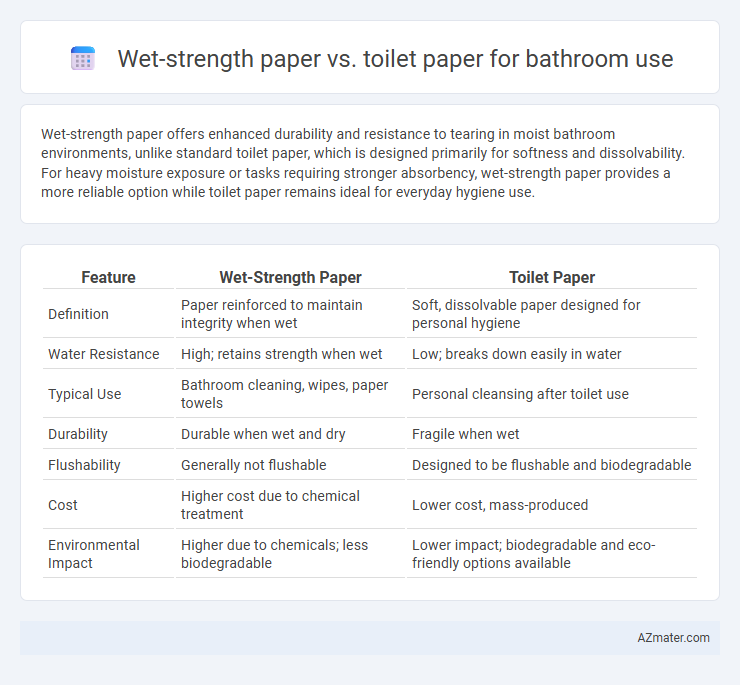Wet-strength paper offers enhanced durability and resistance to tearing in moist bathroom environments, unlike standard toilet paper, which is designed primarily for softness and dissolvability. For heavy moisture exposure or tasks requiring stronger absorbency, wet-strength paper provides a more reliable option while toilet paper remains ideal for everyday hygiene use.
Table of Comparison
| Feature | Wet-Strength Paper | Toilet Paper |
|---|---|---|
| Definition | Paper reinforced to maintain integrity when wet | Soft, dissolvable paper designed for personal hygiene |
| Water Resistance | High; retains strength when wet | Low; breaks down easily in water |
| Typical Use | Bathroom cleaning, wipes, paper towels | Personal cleansing after toilet use |
| Durability | Durable when wet and dry | Fragile when wet |
| Flushability | Generally not flushable | Designed to be flushable and biodegradable |
| Cost | Higher cost due to chemical treatment | Lower cost, mass-produced |
| Environmental Impact | Higher due to chemicals; less biodegradable | Lower impact; biodegradable and eco-friendly options available |
Introduction to Wet-Strength Paper and Toilet Paper
Wet-strength paper is treated with special resins or chemicals to enhance its durability and resistance to moisture, making it ideal for applications where paper needs to maintain integrity when wet, such as in labels, packaging, and certain bathroom products. Toilet paper is designed primarily for softness, disintegration, and biodegradability to ensure comfort and effective flushing in bathrooms, distinguishing it from wet-strength paper formulations. Understanding the differences in composition and performance is essential for selecting the appropriate paper product for specific bathroom uses.
Understanding Wet-Strength Paper Technology
Wet-strength paper incorporates specialized resins like polyamide-epichlorohydrin (PAE) to enhance fiber bonding, significantly improving durability and resistance to disintegration when exposed to moisture. This advanced wet-strength technology makes it ideal for applications requiring temporary water resistance, such as paper towels and certain hygienic products, unlike regular toilet paper designed to dissolve easily in water. Understanding the molecular structure and resin integration within wet-strength paper explains its superior performance in bathroom environments where moisture exposure is frequent but material integrity remains essential.
Toilet Paper: Features and Common Uses
Toilet paper is designed with softness, rapid disintegration, and safe flushability, ensuring it effectively cleans while preventing plumbing blockages. It typically features multiple plies and gentle textures to enhance comfort during bathroom use. Unlike wet-strength paper, which resists moisture for industrial or packaging applications, toilet paper prioritizes biodegradability and user hygiene in domestic settings.
Durability: Wet-Strength vs. Traditional Toilet Paper
Wet-strength paper exhibits enhanced durability by maintaining structural integrity when exposed to moisture, making it ideal for bathroom use where wet conditions are common. Traditional toilet paper tends to disintegrate quickly upon contact with water, reducing its effectiveness during use. The reinforced fibers in wet-strength paper prevent rapid breakdown, providing a sturdier and more reliable option for hygiene purposes.
Water Resistance Comparison
Wet-strength paper is engineered with specialized resins to maintain structural integrity and resist disintegration when exposed to water, making it ideal for applications requiring durability in moist environments. Toilet paper dissolves rapidly upon contact with water to prevent plumbing blockages, resulting in low water resistance and quick breakdown. For bathroom use where prolonged exposure to moisture occurs, wet-strength paper offers superior water resistance compared to standard toilet paper.
Comfort and Skin Sensitivity Considerations
Wet-strength paper offers superior durability and moisture resistance, making it less likely to disintegrate during use, which enhances comfort by reducing irritation and the need for excessive wiping. Toilet paper designed for bathroom use typically prioritizes softness and gentleness, catering to sensitive skin to prevent irritation or allergic reactions. Choosing hypoallergenic, fragrance-free toilet paper minimizes discomfort for users with sensitive skin, while wet-strength paper ensures effective cleaning without compromising skin comfort.
Environmental Impact and Biodegradability
Wet-strength paper contains chemical additives that enhance durability and water resistance but complicate its biodegradability, leading to longer decomposition times and increased environmental impact. Toilet paper is typically designed for rapid disintegration in water, promoting faster biodegradation and reducing stress on sewage systems and ecosystems. Choosing biodegradable toilet paper over wet-strength options significantly decreases landfill waste and supports sustainable bathroom practices.
Cost Differences and Economic Factors
Wet-strength paper offers enhanced durability for bathroom use but generally comes at a higher cost compared to standard toilet paper due to its specialized resin treatment. The increased price reflects manufacturing complexities and longer-lasting performance, which can reduce overall consumption frequency. Economically, choosing wet-strength paper may justify the upfront expense in commercial or high-traffic settings by minimizing waste and maintenance costs, while typical residential use often favors the affordability of conventional toilet paper.
Suitability for Bathroom Applications
Wet-strength paper is engineered to resist disintegration when exposed to moisture, making it suitable for bathroom applications where durability against water is essential, such as for cleaning or wiping surfaces. Toilet paper, on the other hand, is designed to dissolve quickly in water to prevent plumbing blockages, prioritizing flushability over strength. Therefore, wet-strength paper offers superior performance for tasks requiring moisture resistance, while toilet paper remains the optimal choice for hygiene and safe disposal in bathroom settings.
Which Paper is Best for Bathroom Use?
Wet-strength paper offers enhanced durability and resistance to moisture, making it ideal for bathroom tasks requiring stronger, longer-lasting sheets such as cleaning or wiping wet surfaces. Toilet paper is specially designed to dissolve quickly in water to prevent plumbing issues, ensuring safe disposal after use. For optimal bathroom use, combining regular toilet paper for hygiene with wet-strength paper for cleaning purposes provides the best balance of functionality and safety.

Infographic: Wet-strength paper vs Toilet paper for Bathroom use
 azmater.com
azmater.com